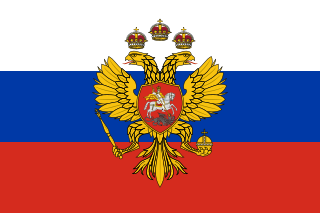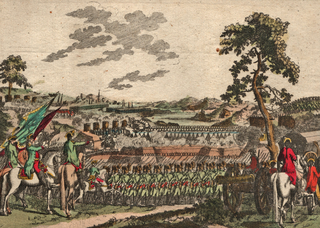
The Battle of Lesnaya was one of the major battles of the Great Northern War. It took place on October 9 [O.S. September 28] 1708 between a Russian army of between 26,500 and 29,000 men commanded by Peter I of Russia, Mikhail Mikhailovich Golitsyn, Aleksandr Danilovich Menshikov, Christian Felix Bauer and Nikolai Grigorovitj von Werden and a Swedish army of about 12,500 men commanded by Adam Ludwig Lewenhaupt and Berndt Otto Stackelberg, at the village of Lesnaya, located close to the border between the Polish–Lithuanian Commonwealth and Russia. The Swedes were escorting a supply column of more than 4,500 wagons for their main army in Ukraine.

The Battle of Poltava was the decisive and largest battle of the Great Northern War. A Russian army under the command of Tsar Peter I defeated a Swedish army, under the command of Carl Gustaf Rehnskiöld. The battle put an end to the status of the Swedish Empire as a European great power, as well as its eastbound expansion, and marked the beginning of Russian influence in Northern Europe.

The Battle of Holowczyn was fought in July 1708 between the Russian army, and the Swedish army, led by Charles XII of Sweden, only 26 years of age at the time. Despite difficult natural obstacles and superior enemy artillery, the Swedes were able to achieve surprise and defeat the numerically superior Russian forces, who were separated from each other, had no overall command and could not coordinate their actions, disallowing them an engagement in full force. Reportedly, it was Charles' favourite victory.
Boris Sokolov, is a historian and a Russian literature researcher. In 1979 he graduated from the department of geography of the Moscow State University, specialising in economic geography. His works have been translated into Japanese, Polish, Latvian and Estonian. He has also translated literary works from various languages.

The storming or battle of Kinburn was fought on 11–12 OctoberN.S./30 September – 1 OctoberO.S. 1787 as part of the Russo-Turkish War (1787–1792).
The Battle of Konotop or Battle of Sosnivka was fought between a coalition led by the Hetman of Ukrainian Cossacks Ivan Vyhovsky and cavalry units of the Russian Tsardom under the command of Semyon Pozharsky and Semyon Lvov, supported by Cossacks of Ivan Bezpaly, on 29 June 1659, near the town of Konotop, Ukraine, during the Russo-Polish War (1654–1667). Vyhovsky's coalition defeated the Russians and their allies and forced the main Russian army to interrupt the siege of Konotop. However, the result of the battle only intensified political tensions in Ukraine and led to Vyhovsky's removal from power several months later.

The Tsardom of Russia, also known as the Tsardom of Muscovy, was the centralized Russian state from the assumption of the title of tsar by Ivan IV in 1547 until the foundation of the Russian Empire by Peter the Great in 1721.

The invasion of Russia by Charles XII of Sweden was a campaign undertaken during the Great Northern War between Sweden and the allied states of Russia, Poland, and Denmark. The invasion began with Charles's crossing of the Vistula on 1 January 1708, and effectively ended with the Swedish defeat in the Battle of Poltava on 8 July 1709, though Charles continued to pose a military threat to Russia for several years while under the protection of the Ottoman Turks.

The Battle of Molyatichi, also known as the Battle of Dobroye, took place on August 31, 1708 at Molyatichi during the Great Northern War. The Russian army of Peter the Great under the command of Mikhail Golitsyn successfully attacked the avantgarde of the Swedish Army of Charles XII under Carl Gustaf Roos. The fighting occurred in the swamp between the rivers Belaya Natopa and Chernaya Natopa. The Swedish force under Roos was surprised by the Russian attack in the morning fog and steadily withdrew towards the main Swedish army. The swampy landscape prevented the Russian cavalry to cut off the Swedish way of retreat. As Swedish reinforcements arrived, the Russians were put on the defensive. Since the attack of the main body of the Swedish army was not part of the Russian intentions at that moment, and to avoid a disastrous defeat, the Russians withdrew. According to the Russian description, this was done in order, while the Swedish one claims their retreat turned into a disorganized flight as the Swedes pursued. Many Russians were killed in the swamps.

The Battle of Grodno (1706) refers to the battle during the Great Northern War. Grodno was a city of the Polish–Lithuanian Commonwealth at this time.

The Shamkhalate of Tarki, or Tarki Shamkhalate was a Kumyk state in the eastern part of the North Caucasus, with its capital in the ancient town of Tarki. It formed on the territory populated by Kumyks and included territories corresponding to modern Dagestan and adjacent regions. After subjugation by the Russian Empire, the Shamkhalate's lands were split between the Empire's feudal domain with the same name extending from the river Sulak to the southern borders of Dagestan, between Kumyk possessions of the Russian Empire and other administrative units.

The Ministry of Communications of the Union of Soviet Socialist Republics (USSR) (Russian: Министерство связи СССР) was the central state administration body on communications in the Soviet Union from 1923 to 1991. During its existence it had three names: People's Commissariat for Posts and Telegraphs (1923–32), People's Commissariat for Communications (1932–46) and Ministry of Communications (1946–1991). It had authority over the postal, telegraph and telephone communications as well as public radio, technical means of radio and television broadcasting, and the distribution of periodicals in the country.

The Battle of Porrassalmi was fought near the bight of Porrassalmi in Savonia on 13 June 1789, during the Russo-Swedish War (1788–90). A Swedish force of about 750 men succeeded in stopping the northbound advance of a Russian force numbering 5,000 men.

Azerbaijani mythology are mythological representations of the Azerbaijani people.
The Battle of Nevel was fought during the Livonian War between the Kingdom of Poland and the Tsardom of Russia on August 19, 1562.

The Swedish invasion of Poland (1701–1706), also known as Charles XII's invasion of Poland or the Polish front of the Great Northern War, was a conflict in eastern Europe overshadowed by the ongoing Great Northern War fought between the Swedish Empire against the Russian Empire, Denmark-Norway, Saxony and the Polish–Lithuanian Commonwealth. The Polish front was a major part of the greater conflict, and it included some decisive battles in favor of the Swedes that contributed to the length of the war.
The Battle of Walk on July 8, 1657 between forces of Sweden commanded by Friedrich von Löwen on one side, and Russian forces led by stolnik Matvey Sheremetyev, who for the first time in his career commanded an army by himself, on the other side. The largest part of the Russian army disobeyed Sheremetyev and left the battle at the beginning, forcing him to rely on the 250 reiters of Colonel Denis Fonvizin, who played the key role in the breakthrough and allowed the rest of the army to escape. The Swedish forces won the battle, and according to their sources they defeated an army of 8,000 men, 32 standards, banners and other field declarations had been captured in the battle and 1,500 Russians were dead or wounded along with their commander Matvey Sheremetyev, who later died in captivity. However, a recent analysis of Russian 17th-century archive documents related to the battle demonstrates that the entire Russian force, most of which escaped, consisted of only 2,193 men, 353 additional troops failed to arrive in time, and even Tsar Alexis I in his correspondence expected his army to be no larger than 3,000, while the casualties included 108 killed, 28 wounded, 5 captured. The Swedish declaration has been criticized by Oleg Kurbatov, an expert in the Russian military history of the 17th century, as often tendentious and inaccurate in its description of the Russian army and having inflated numbers.

The Campaign of Grodno was a plan developed by Johann Patkul and Otto Arnold von Paykull during the Swedish invasion of the Polish–Lithuanian Commonwealth, a part of the Great Northern War. Its purpose was to crush Charles XII's army with overwhelming force in a combined offensive of Russian and Saxon troops. The campaign, executed by Peter I of Russia and Augustus II of Saxony, began in July 1705 and lasted almost a year. In divided areas the allies would jointly strike the Swedish troops occupied in Poland, in order to neutralize the influence the Swedes had in the Polish politics. However, the Swedish forces under Charles XII successfully outmaneuvered the allies, installed a Polish king in favor of their own and finally won two decisive victories at Grodno and Fraustadt in 1706. This resulted in the Treaty of Altranstädt (1706) in which Augustus renounced his claims to the Polish throne, broke off his alliance with Russia, and established peace between Sweden and Saxony.
The Kanzhal War or Crimean-Circassian War of 1708 was military conflict in 1708 fought between 7,000 Circassians led by Kurgoqo Atajuq and 60,000–100,000 Crimean Tatars led by Qaplan I Giray, which resulted in Circassian victory. It played a big role in decreasing foreign influence in Circassia. In 2013, the Russian Academy of Sciences described the battle as "an important event in the history of Circassians". It was fought near the village of Bylym on the Baksan River.












